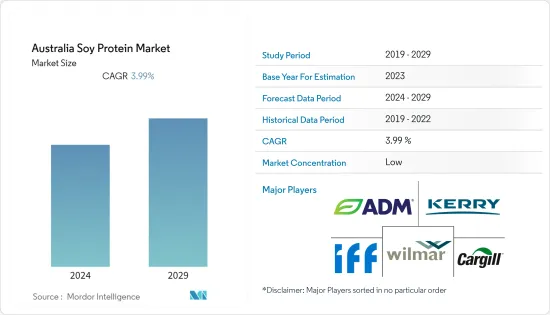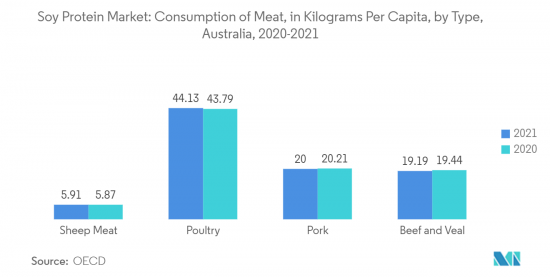PUBLISHER: Mordor Intelligence | PRODUCT CODE: 1406976

PUBLISHER: Mordor Intelligence | PRODUCT CODE: 1406976
Australia Soy Protein - Market Share Analysis, Industry Trends & Statistics, Growth Forecasts 2024 - 2029

The Australia soy protein market size is expected to grow from USD 88.53 million in 2024 to USD 107.63 million by 2029, at a CAGR of 3.99% during the forecast period (2024-2029).
Key Highlights
- The Australian soy protein market is primarily driven by its applications in the food and beverage industry. The demand for plant-based meat products is increasing in the country owing to the increasing demand for clean-label food in the market. Additionally, due to rising health consciousness and increasing demand for functional and nutritional food, the demand for soy protein is growing. The soy protein concentrates are claimed to provide good protein content, better hydration, and immunity-boosting nutrients.
- The high penetration rate of soy protein in the Australian food and beverage market can be attributed to the abundant availability of raw materials and lower prices. During the review period, soy protein was 40%-50% cheaper than other proteins, like pea protein. Steady innovations in the RTE food segment led to the wide application of soy protein incorporated in various products, such as burger patties, minced meat analog, meatballs, and sausages. Owing to this, the use of soy protein concentrate as a bakery ingredient is increasing.
- Additionally, the demand for soy protein in animal feed is also increasing owing to the increasing demand for nutritional animal feed among meat suppliers. According to Alltech Feed Survey 2021, animal feed production in Australia majorly comes from more than 160 mills in the country. In animal feed, soy protein is primarily used as a dairy substitute and fishmeal for its functionalities, including high protein digestibility, cheaper price point, low anti-nutritional content, and longer shelf life.
- Furthermore, the production of soya beans is increasing in Australia owing to the environmental conditions and market demand for plant-based ingredients. According to the Australian Bureau of Statistics, the soybean yield in Australia in 2021 was 1.7 million metric tons per hectare.
Australia Soy Protein Market Trends
Rising Demand for Plant-based Protein Sources
- The emergence of vegetable protein from sources like soy demonstrates a change in customer demand from animal protein to plant protein with similar functional and nutritional characteristics. This incremental shift toward a plant-based diet is primarily influenced by various factors, including ecological concerns, health consciousness, ethical or religious beliefs, and environmental and animal rights. Although meat proteins provide the body with the necessary amino acid content, they are also associated with high cholesterol levels, obesity, digestion problems, and other related health issues. The country has a high per capita meat consumption, which is the main source of protein.
- For instance, according to The Organisation for Economic Co-operation and Development (OECD), in 2021, Australians consumed around 44.13 kilos of poultry on average. Increasing awareness of the negative effects of high meat consumption is leading many Australians to rethink their food choices and adopt a plant-based diet, further paving the way for soy protein products.
- Soy protein is considered an ideal meat substitute and is gaining higher traction among vegan and flexitarian consumers. This phenomenon augmented the growth of the product, which helps food manufacturers provide a meat-like nutrition profile to their portfolio of faux meat or vegan meat products such as nuggets, burger patties, sausages, and crumbles. In December 2022, Harvest B, a B2B protein alternative company, opened its meat substitute ingredient facility in Western Sydney. Harvest B states that the establishment is a modern facility equipped with the most up-to-date manufacturing equipment for the production of soy, peas, wheat, and oat proteins. Hence, the growth of the plant-based meat industry can play a crucial role in driving the market studied, as soy proteins are widely used in making meat substitutes.

Animal Feed as the Largest Segment by End-User Industry
- Soy proteins are widely used in the animal feed sector in the country, owing to their distinct benefits, such as apt amino acid profile, among other benefits. Soy protein concentrates are widely used across the animal feed industry as they have high protein digestibility and optimal nutritional value, making them an ideal protein source for animal feed. Also, it being cheaper than isolates further drives its use.
- Approximately 85% of the total soybean meal usage in Australia is to feed pigs and poultry, thereby driving the application of soy protein in the Australian feed industry. Soy protein meal is processed for livestock feed. Soy animal feed is the single most important source of protein for farm animals. Soybean meal is the standard for poultry and other livestock, far surpassing other feeds when it comes to protein content.
- Additionally, animal feed manufacturers are continuously seeking new protein ingredients that are high-quality, cost-effective, and label-friendly. Soybean meals are frequently used by pig & poultry industries across Australia. Owing to this, companies have been offering products to cater to the growing demand. For instance, The Archer-Daniels-Midland Company offers soy proteins for the animal feed industry across Australia.
- To cater to the demand for meat across the nation, the rearing of livestock and production of meat has been rising in Australia. According to the Australian Bureau of Statistics, the gross value of poultry in Australia in the year 2022 was approximately AUD 3.18 billion (USD 2.89 billion). Hence, the growing poultry and other meat industry could, in turn, drive the soy protein market across Australia.
Australia Soy Protein Industry Overview
The Australian soy protein market is fragmented in nature, with several players offering soy protein products in the market. The major players in this market include Cargill, Incorporated, Archer Daniels Midland Company, International Flavors & Fragrances, Inc., Wilmar International Ltd., and Kerry Group PLC. The companies have been using various corporate strategies to increase their foothold in the Australian soy protein market. Some of the majorly adopted strategies by the players offering soy protein across the nation include partnerships, mergers & acquisitions, and expansions. Archer Daniels Midland Company also has a significant share in the market, and it is mainly focused on plant proteins like pea protein, soy protein, textured protein ingredients, and wheat protein. The company innovates new technologies for the use of proteins in several applicational segments like food, beverages, animal feed, supplements, personal care, and cosmetic products.
Additional Benefits:
- The market estimate (ME) sheet in Excel format
- 3 months of analyst support
TABLE OF CONTENTS
1 INTRODUCTION
- 1.1 Study Assumptions and Market Definition
- 1.2 Scope of the Study
2 RESEARCH METHODOLOGY
3 EXECUTIVE SUMMARY
4 MARKET DYNAMICS
- 4.1 Market Drivers
- 4.1.1 Rising Demand for Plant-based Protein Sources
- 4.1.2 Strategic Investments by Players Operating in the Market
- 4.2 Market Restraints
- 4.2.1 Availability of Substitute Protein Sources
- 4.3 Porter's Five Forces Analysis
- 4.3.1 Threat of New Entrants
- 4.3.2 Bargaining Power of Buyers/Consumers
- 4.3.3 Bargaining Power of Suppliers
- 4.3.4 Threat of Substitute Products
- 4.3.5 Intensity of Competitive Rivalry
5 MARKET SEGMENTATION
- 5.1 Form
- 5.1.1 Concentrates
- 5.1.2 Isolates
- 5.1.3 Textured/Hydrolyzed
- 5.2 End User
- 5.2.1 Animal Feed
- 5.2.2 Personal Care and Cosmetics
- 5.2.3 Food and Beverages
- 5.2.3.1 Bakery
- 5.2.3.2 Beverages
- 5.2.3.3 Breakfast Cereals
- 5.2.3.4 Condiments/Sauces
- 5.2.3.5 Dairy and Dairy Alternative Products
- 5.2.3.6 Meat/Poultry/Seafood and Meat Alternative Products
- 5.2.3.7 RTE/RTC Food Products
- 5.2.3.8 Snacks
- 5.2.4 Supplements
- 5.2.4.1 Baby Food and Infant Formula
- 5.2.4.2 Elderly Nutrition and Medical Nutrition
- 5.2.4.3 Sport/Performance Nutrition
6 COMPETITIVE LANDSCAPE
- 6.1 Strategies Adopted by Leading Players
- 6.2 Market Share Analysis
- 6.3 Company Profiles
- 6.3.1 Cargill, Incorporated,
- 6.3.2 Archer Daniels Midland Company
- 6.3.3 Bunge Limited
- 6.3.4 International Flavors & Fragrances
- 6.3.5 FoodChem International Corporation
- 6.3.6 Kerry Group PLC
- 6.3.7 Wilmar International Ltd
- 6.3.8 Agro Solvent Products Pvt. Ltd
- 6.3.9 Ingredion Incorporated
- 6.3.10 CHS Inc.
7 MARKET OPPORTUNITIES AND FUTURE TRENDS




